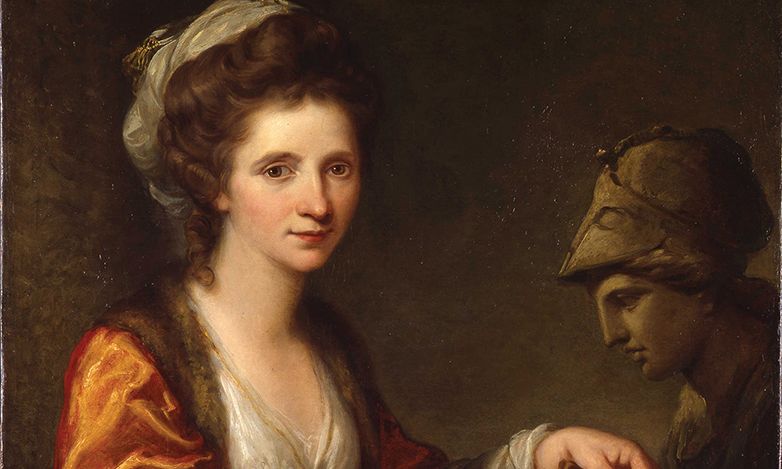Angelica Kauffman’s Self-portrait with Bust of Minerva (around 1780), one of several self-portraits she painted Gottfried Keller Foundation, Federal Office of Culture, Bern
You could call the Angelica Kauffman exhibition at the Royal Academy of Arts (RA) in London a homecoming. Born in the Alpine city of Chur in 1741, the Swiss artist moved to London in her early 20s and became one of the art institution’s founding members in 1768. “She was one of the few who encapsulated what the academy was about in terms of promoting history painting and grand portraits,” says the curator Annette Wickham. “In addition, she was one of only two women to be part of the original group, after which women were excluded from membership for the rest of the 19th century, which makes this inclusive moment in the academy’s history all the more intriguing.”
Co-curated with Bettina Baumgärtel, the exhibition opened at the Kunstpalast in Düsseldorf in January 2020 and was due to travel to the RA later that year before being postponed due to the Covid-19 pandemic. Like the original show, the London iteration will be largely chronological and cover the breadth of Kauffman’s career, with some 30 works that chart four key stages of her life. The main difference is that Wickham has expanded the section on her London years and homed in on her reputation and relations within the academy.
Kauffman’s talent was recognised from a young age, not only in art but also in music and literature. Her family moved around Switzerland, Austria and Germany, exposing her to different cultures, and in the early 1760s she studied classical sculpture and the Old Masters in Italy with her father, the painter Johann Joseph Kauffman.
Kauffman's Portrait of Joshua Reynolds (1767) led to many high-profile commissions Photo: © National Trust Images/Rob Matheson
In Rome she received commissions from fellow artists and scholars, among them the German art historian Johann Joachim Winckelmann, whom she captures in casual clothing at his desk, deep in contemplation. According to Wickham, it was Kauffman’s decision to paint illustrious sitters informally and intimately that set her apart from other popular portraitists of the time.
As savvy as she was talented, Kauffman had a knack for befriending the right people; she was aware that painting famous figures would help to make her famous, too. Upon moving to London in 1766, one of her first portraits was of Joshua Reynolds, whom she had just met, and pictures of the royals followed. The exhibition will begin with her most celebrated self-portraits, which enabled her to shape her identity and image. She was keen to have her work reproduced as prints to get her name out.
Although successful as a portraitist, Kauffman regarded herself primarily as a history painter, a genre prized by the academy, and to which she brought great originality. “Without wanting to paint her as a dedicated feminist before her time, she certainly had an interest in finding active and interesting stories about women, and portraying them in unexpected ways,” Wickham says. Cleopatra Adorning the Tomb of Mark Anthony (around 1769), for instance, shows the Egyptian queen not as exoticised seductress but as grieving widow, modestly dressed.
The section devoted to Kauffman and the RA will explore her rise in the male-dominated 18th century, from relative outsider—as seen in Johan Zoffany’s The Academicians of the Royal Academy (1771-72), a famous group portrait of the founding members that relegates Kauffman and the painter Mary Moser to half-finished portraits on the wall—to being commissioned to paint four oval ceiling panels for the academy’s original home at Somerset House. Two of the panels, now usually on display in the RA’s entrance hall, will be in the exhibition, while the other two are due to go on loan to Tate Britain in May for a sweeping show of women artists.
The RA exhibition will end with Kauffman’s late career in Rome, where she returned in 1782 after 15 years in London. Over the following decade she extended her clientele and friendship circle, had a celebrated salon and studio, and continued to paint for several British patrons.
So why, as is the case with so many women artists, was she later sidelined from art history? In the early 19th century, her reputation waned as Neoclassical art fell out of fashion in favour of Romanticism, and reproductions of her work on furniture and other decorative objects meant it was no longer seen as serious art, but as prettified and domestic. Though Kauffman remained in the record, there was a tendency for historians to focus more on her life and less on her work. And yet, as Wickham says, hers is “a positive story that shows her tenacity and ability to stand her ground and prove her worth—she had to, which is a shame, but she was successful”.
• Angelica Kauffman, Royal Academy of Arts, London, 1 March-30 June

